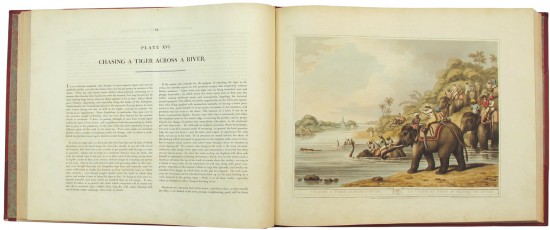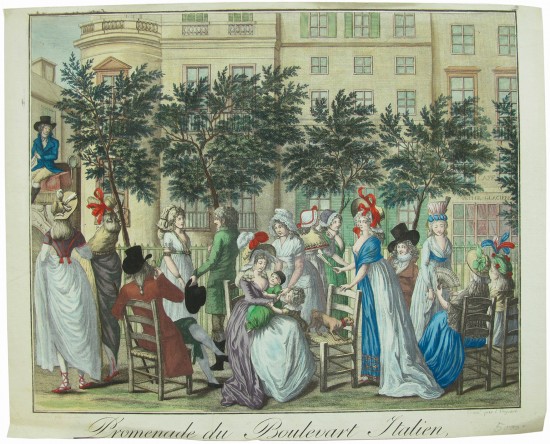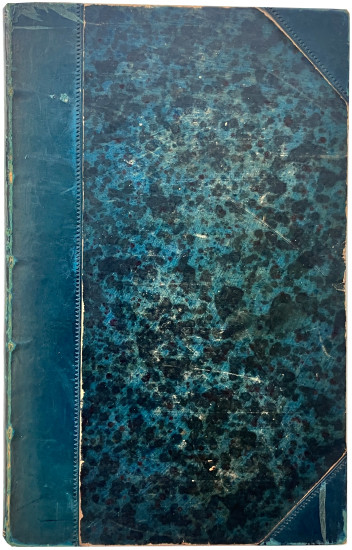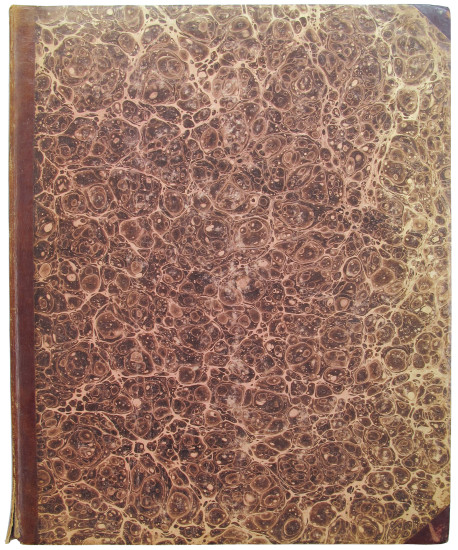Méthode et Invention Nouvelle de Dresser les Chevaux Par le Tres-Noble, Haut, et Tres-Puissant Prince Guillaume, Marquis et Comte de Newcastle, Vicomte de Mansfield, Baron de Bolsover et Ogle &c. &c
Newcastle, William Cavendish, Duke of
London. Chez Jean Brindley, Libraire de S.A.R. Monseigneur de Galles, dans New Bond-street. 1737
Dr. Richard Mead's copy of the second edition of Cavendish's famous equine treatise bound in contemporary English red morocco with a rare contemporary fore-edge painting of Mead's and his wife's arms, the binding and fore-edge by John Brindley who was, in addition, the publisher of the work.
'Dr. Richard Mead lived more in the broad sunshine of life than any almost any man.' (Dr. Johnson).
First printed at Anvers in 1658 during Cavendish's self-imposed exile during the English Civil War, this second edition was printed on a better quality of paper using the same plates as for the first edition. Cavendish (1592 - 1676), a staunch Royalist, was raised to the Dukedom of Newcastle at the Restoration of Charles II in 1660, hence the omission of that title on the title of the present work. The archetypal Stuart courtier and aristocrat, the very wealthy and landed Cavendish was a poet, scholar, diplomat, soldier, architect and a famous and accomplished horseman.
Cavendish's 'Methode et Invention Nouvelle de Dresser les Chevaux' sets out the influential lessons for schooling horses ('l'art de manège') employed by Cavendish himself at his famous riding school. As well as allegorical compositions, a portrait of Cavendish surrounded by worshipping horses, a portrait of Charles II (who was entrusted to Cavendish by his father Charles I for his education) and a group portrait of the Cavendish family, the work features 24 plates of training, many depicting Cavendish himself, as well as his assistant Captain Mazin. The large number of woodcuts in the text depict (in the main) the technical footwork required by the horses in their schooling. While at Anvers Cavendish inhabitated the Rubenshuis, Peter Paul Rubens home for the last three decades of his life; Abraham van Diepenbeke who designed the plates of the work had been a pupil of Rubens.
Dr. Richard Mead (1673 - 1754) was an important philanthropist, patron, collector, physician, classicist, antiquarian, scholar, bibliophile and author (in no order of priority). Satirised by Sterne as 'Dr. Kunastrolius', as a Royal physician Mead attended Queen Anne on her deathbed and was later physician to George II as Prince of Wales and as King as well as to Sir Isaac Newton. Mead succeeded John Radcliffe as the most important medical man in Britain, pioneered inoculation with Sir Hans Sloane and was influential in the establishment of Thomas Coram's 'Foundling Hospital'; Mead's Bloomsbury house in Great Ormond Street later became the 'Hospital for Sick Children' (now the Great Ormond Street Hospital or GOSH). Mead had an astonishing collection of paintings including Holbein's portrait of Erasmus, Titian's portrait of Vesalius, Kneller's portrait of Edmund Halley and works by Canaletto, Claude, Rembrandt, Brueghel and Poussin. He also owned extensive series of prints and drawings and commissioned works by Watteau and Scheemakers.
'Rare monkish manuscripts for Hearne alone, / And books for Mead and butterflies for Sloane.' (Alexander Pope).
As a bibliophile, Mead was almost unrivalled, ODNB states that 'Mead's collection of books and manuscripts was second only to that of Hans Sloane', adding the detail that he owned over 10,000 volumes including 146 incunabulae. His collection was sold as the 'Bibliotheca Meadiana' - unlike Sloane he wished for the dispersal of his collection - in two sales, the first between November 18th and December 19th, 1754, over 28 days, the second between April 7th and May 8th, 1755, over 28 days. The whole collection achieved £5,540-7-6 (bookcases included) and featured Mead's copy of Vesalius' 'Epitome' on vellum (now in the British Library), a copy of the 1469 Pliny purchased by Louis XV of France, a Shakespeare Second Folio that had belonged to Charles I, incunable editions of Vitruvius and Alberti, the 1486 Lucretius (described in Mead's sale catalogue as 'editio princeps' but not so) and many other important books in the fields of anatomy and architecture; although Mead was a classicist and both literate and literary to a profound degree he was not interested in the work of his contemporaries and his collection included only Henry Fielding's 'The History of Tom Jones, a Foundling'. The present volume appears as lot 402 sold on the 'Thirteenth Day's Sale' in the first sale on Monday, December 2nd, 1754 where it is described as 'C. M. C. T. F. D.', i.e. 'Charta Maxima' (large paper), 'Corio Turcico' (Turkey leather i.e. morocco) and 'Foliis Deauratis' (gilt edges).
The elaborate fore-edge decoration - painted beneath the gilding of the page edges - features the arms of Dr. Richard Mead (1673- 1754) combined with those of his wife, Anne (1689 - 1763), daughter of Sir Rowland Alston, Bart., as follows: a shield surmounted by an eagle displayed above a coronet, a shield below of three white pelicans divided by a chevron against a black background, sinister (Mead's arms) and dexter, ten stars against an azure field (the Alston arms), below the motto 'NON SIBI SED TOTI' within a banner; the arms are flanked by horns of plenty, garlands, insects and sprays of flowers. The publisher of the book was the bookbinder, publisher and bookseller John Brindley, binder to Queen Charlotte (wife of George II) and Frederick, Prince of Wales, known both for his bindings and for the beautiful and elaborate fore-edge paintings executed on some of the books he bound. Weber (see below) details six bindings with fore-edge paintings by Brindley, all with Royal arms or initials (of George I, George II or the majority (four) for his Queen, Caroline of Ansbach) and all now in either the British Library or Royal Collection. The present fore-edge suggests that Brindley executed more such paintings - although likely only for patrons of considerable stature such as Mead - and further research may reveal others.
Mead and Brindley were connected in books: it is likely that Brindley as a bookseller was influential in the enlargement of Mead's library and Mead had given permission to Brindley to publish an English translation, 'Discourse on the Small-Pox and Measles', of his Latin 'De Variolis et Morbillis Liber' after Mead's 'Mechanical Account of Poisons' and his 'De Imperio Solis ac Lunae in Corpora Humana' in 1746. Mead ('The Oldest Bookshop in London' describes him as Brindley's 'patron, Dr. Mead') recommended Brindley as a bookseller in 1736 - the year before the publication of Cavendish's 'Methode' - to the 'Society for the Incouragement [sic] of Learning' (see 'The Oldest Bookshop in London') and Brindley in his own letter soliciting their patronage references Mead, his Royal connections and his own practise as a binder and although he was unsuccessful initially he was later appointed as one of the society's booksellers. In 1755 Brindley published English versions - posthumous editions - of Mead's 'Medica Sacra' and his 'Monita et Praecepta Medica' and in the year prior to Brindley's death, 1757, he published another edition of Mead's 'On the Scurvy'.
'English binder, publisher and bookseller ... Brindley is one of the few known English binders who made fore-edge paintings after the Restoration period until Edwards of Halifax emerges in the latter half of the eighteenth-century ... '. (Jeff Weber).
[see Jeff Weber's 'Annotated Dictionary of Fore-Edge Painting Artists & Binders &c.' Los Angeles, 2010, pp. 65 - 68; see 'Mead' in Dr. Bisset Hawkins' 'Lives of British Physicians', London, 1830, pp. 155 - 167; see also 'George Smith's and Frank Benger's 'The Oldest London Bookshop - A History of Two Hundred Years &c.', London, 1928, pp. 3 - 20 and especially 15 - 16].
'Dr. Richard Mead lived more in the broad sunshine of life than any almost any man.' (Dr. Johnson).
First printed at Anvers in 1658 during Cavendish's self-imposed exile during the English Civil War, this second edition was printed on a better quality of paper using the same plates as for the first edition. Cavendish (1592 - 1676), a staunch Royalist, was raised to the Dukedom of Newcastle at the Restoration of Charles II in 1660, hence the omission of that title on the title of the present work. The archetypal Stuart courtier and aristocrat, the very wealthy and landed Cavendish was a poet, scholar, diplomat, soldier, architect and a famous and accomplished horseman.
Cavendish's 'Methode et Invention Nouvelle de Dresser les Chevaux' sets out the influential lessons for schooling horses ('l'art de manège') employed by Cavendish himself at his famous riding school. As well as allegorical compositions, a portrait of Cavendish surrounded by worshipping horses, a portrait of Charles II (who was entrusted to Cavendish by his father Charles I for his education) and a group portrait of the Cavendish family, the work features 24 plates of training, many depicting Cavendish himself, as well as his assistant Captain Mazin. The large number of woodcuts in the text depict (in the main) the technical footwork required by the horses in their schooling. While at Anvers Cavendish inhabitated the Rubenshuis, Peter Paul Rubens home for the last three decades of his life; Abraham van Diepenbeke who designed the plates of the work had been a pupil of Rubens.
Dr. Richard Mead (1673 - 1754) was an important philanthropist, patron, collector, physician, classicist, antiquarian, scholar, bibliophile and author (in no order of priority). Satirised by Sterne as 'Dr. Kunastrolius', as a Royal physician Mead attended Queen Anne on her deathbed and was later physician to George II as Prince of Wales and as King as well as to Sir Isaac Newton. Mead succeeded John Radcliffe as the most important medical man in Britain, pioneered inoculation with Sir Hans Sloane and was influential in the establishment of Thomas Coram's 'Foundling Hospital'; Mead's Bloomsbury house in Great Ormond Street later became the 'Hospital for Sick Children' (now the Great Ormond Street Hospital or GOSH). Mead had an astonishing collection of paintings including Holbein's portrait of Erasmus, Titian's portrait of Vesalius, Kneller's portrait of Edmund Halley and works by Canaletto, Claude, Rembrandt, Brueghel and Poussin. He also owned extensive series of prints and drawings and commissioned works by Watteau and Scheemakers.
'Rare monkish manuscripts for Hearne alone, / And books for Mead and butterflies for Sloane.' (Alexander Pope).
As a bibliophile, Mead was almost unrivalled, ODNB states that 'Mead's collection of books and manuscripts was second only to that of Hans Sloane', adding the detail that he owned over 10,000 volumes including 146 incunabulae. His collection was sold as the 'Bibliotheca Meadiana' - unlike Sloane he wished for the dispersal of his collection - in two sales, the first between November 18th and December 19th, 1754, over 28 days, the second between April 7th and May 8th, 1755, over 28 days. The whole collection achieved £5,540-7-6 (bookcases included) and featured Mead's copy of Vesalius' 'Epitome' on vellum (now in the British Library), a copy of the 1469 Pliny purchased by Louis XV of France, a Shakespeare Second Folio that had belonged to Charles I, incunable editions of Vitruvius and Alberti, the 1486 Lucretius (described in Mead's sale catalogue as 'editio princeps' but not so) and many other important books in the fields of anatomy and architecture; although Mead was a classicist and both literate and literary to a profound degree he was not interested in the work of his contemporaries and his collection included only Henry Fielding's 'The History of Tom Jones, a Foundling'. The present volume appears as lot 402 sold on the 'Thirteenth Day's Sale' in the first sale on Monday, December 2nd, 1754 where it is described as 'C. M. C. T. F. D.', i.e. 'Charta Maxima' (large paper), 'Corio Turcico' (Turkey leather i.e. morocco) and 'Foliis Deauratis' (gilt edges).
The elaborate fore-edge decoration - painted beneath the gilding of the page edges - features the arms of Dr. Richard Mead (1673- 1754) combined with those of his wife, Anne (1689 - 1763), daughter of Sir Rowland Alston, Bart., as follows: a shield surmounted by an eagle displayed above a coronet, a shield below of three white pelicans divided by a chevron against a black background, sinister (Mead's arms) and dexter, ten stars against an azure field (the Alston arms), below the motto 'NON SIBI SED TOTI' within a banner; the arms are flanked by horns of plenty, garlands, insects and sprays of flowers. The publisher of the book was the bookbinder, publisher and bookseller John Brindley, binder to Queen Charlotte (wife of George II) and Frederick, Prince of Wales, known both for his bindings and for the beautiful and elaborate fore-edge paintings executed on some of the books he bound. Weber (see below) details six bindings with fore-edge paintings by Brindley, all with Royal arms or initials (of George I, George II or the majority (four) for his Queen, Caroline of Ansbach) and all now in either the British Library or Royal Collection. The present fore-edge suggests that Brindley executed more such paintings - although likely only for patrons of considerable stature such as Mead - and further research may reveal others.
Mead and Brindley were connected in books: it is likely that Brindley as a bookseller was influential in the enlargement of Mead's library and Mead had given permission to Brindley to publish an English translation, 'Discourse on the Small-Pox and Measles', of his Latin 'De Variolis et Morbillis Liber' after Mead's 'Mechanical Account of Poisons' and his 'De Imperio Solis ac Lunae in Corpora Humana' in 1746. Mead ('The Oldest Bookshop in London' describes him as Brindley's 'patron, Dr. Mead') recommended Brindley as a bookseller in 1736 - the year before the publication of Cavendish's 'Methode' - to the 'Society for the Incouragement [sic] of Learning' (see 'The Oldest Bookshop in London') and Brindley in his own letter soliciting their patronage references Mead, his Royal connections and his own practise as a binder and although he was unsuccessful initially he was later appointed as one of the society's booksellers. In 1755 Brindley published English versions - posthumous editions - of Mead's 'Medica Sacra' and his 'Monita et Praecepta Medica' and in the year prior to Brindley's death, 1757, he published another edition of Mead's 'On the Scurvy'.
'English binder, publisher and bookseller ... Brindley is one of the few known English binders who made fore-edge paintings after the Restoration period until Edwards of Halifax emerges in the latter half of the eighteenth-century ... '. (Jeff Weber).
[see Jeff Weber's 'Annotated Dictionary of Fore-Edge Painting Artists & Binders &c.' Los Angeles, 2010, pp. 65 - 68; see 'Mead' in Dr. Bisset Hawkins' 'Lives of British Physicians', London, 1830, pp. 155 - 167; see also 'George Smith's and Frank Benger's 'The Oldest London Bookshop - A History of Two Hundred Years &c.', London, 1928, pp. 3 - 20 and especially 15 - 16].
[2 blank leaves, engraved title, printed title, various dedications (see below), engraved plates, pp. 236 (Books I - IV, 'Abbregé de la Cavalerie', 'Conclusion au Lecteur', 'Additions', 'Table', 2 blank leaves]. Folio. (538 x 375 mm). Double-page engraved illustrated title leaf, printed title with woodcut vignette, leaf with Brindley's dedication to 'Henriette Cavendish-Holles, Countes of Oxford & Mortimer', leaf with 'Avertissement sur cette Seconde Edition', 3 leaves with Newcastle's 'Au Roy de la Grande Bretagne', additional dedications to 'Mes Tres-Chers Fils le Seigneur Charles, Vicomte de Mansfield et le Seigneur Henry Cavendish' and to 'Tous Honorable Cavaliers, et aux Tres-Excellens Cavallerizzes' and 42 double-page engraved plates, all on single sheets and mounted on guards by various engravers (Lisbetten, Vostermans, Kessel, Clouwet &c.) after Van Diepenbeke and numerous woodcuts throughout. (Sheet size: c.525 x 630 mm). Engraved and woodcut head- and tail-pieces throughout, decorative woodcut 4-line initials for each chapter opening. Four leaves of text (pages 81 - 84 and 87 - 90) are very slightly shorter (remargined at foot) and may have been supplied from another copy. Occasional slight browning and foxing but overall a crisp, clean copy. Contemporary English red morocco by John Brindley, boards with elaborate gilt-tooled borders, banded spine in eight compartments with morocco title label with gilt title and black morocco sections with elaborate decorative tooling in alternating compartments, board edges with gilt decoration, turn-ins with additional gilt tooling, marbled endpapers, a.e.g., fore-edge with elaborate contemporary painted decoration (see below) beneath the gilding also by John Brindley.
#48492











